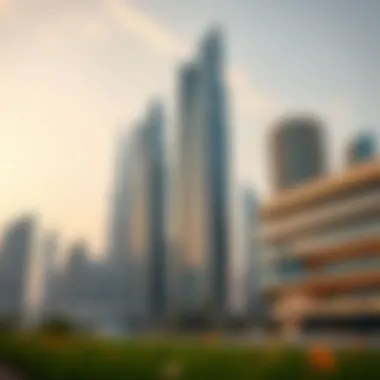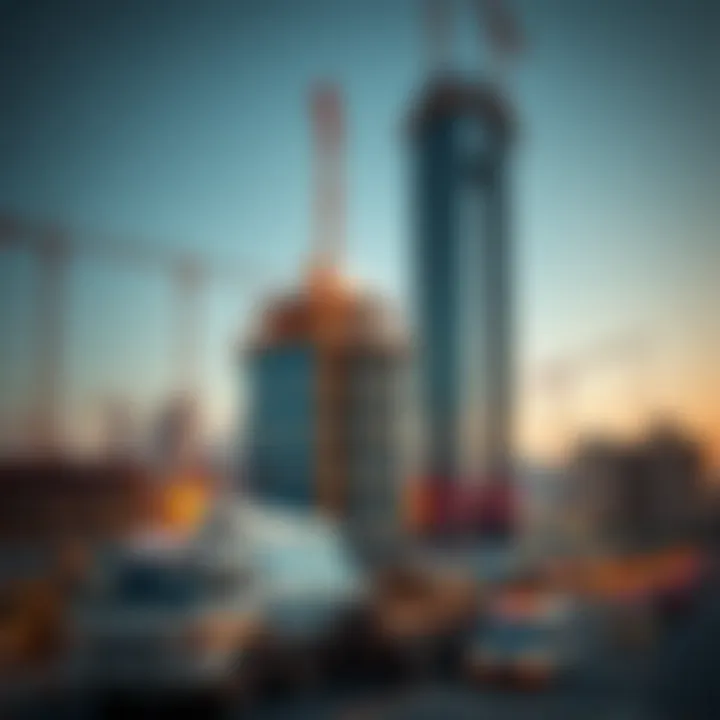Leading Developers in the UAE: An In-Depth Analysis


Intro
The real estate scene in the United Arab Emirates is a tapestry woven with innovation, ambition, and remarkable achievements. As one of the most dynamic landscapes in the world, the UAE has attracted a myriad of developers, each making substantial strides in shaping its urban environment. To anyone eyeing investment opportunities or simply wanting to understand the industry, knowing the leading developers becomes essential.
This guide serves as a deep dive, through the lens of both statistics and personal experience, focusing on who’s who in this rapidly changing market. The article dissects the strategic approaches and hallmark projects that define the key players in UAE's real estate sector, thus illuminating the paths of potential investors, homeowners, and market analysts alike. Developers not only construct buildings; they craft communities, and this narrative seeks to paint a vivid picture of that reality.
It’s more than just bricks and mortar. It’s about understanding trends and forecasting where to place your bets. With a solid grasp of what each developer offers, investors can better navigate the market and make informed decisions. Now, let’s delve into the core topics that will guide this exploration.
Overview of the UAE Real Estate Sector
The real estate sector in the United Arab Emirates holds a significant weight in the country’s economy, acting as a barometer for both local and foreign investments. Its evolution is closely tied to the UAE's aggressive economic diversification strategies, showcasing a growing trend toward urbanization and infrastructure development. Understanding the landscape of the UAE real estate market is crucial for potential investors, homeowners, and market analysts alike. The sector's dynamism not only reflects current economic activities but also projects future opportunities and challenges.
Current Market Trends
The current market trends in the UAE real estate sector illustrate a complex yet promising scenario. In recent years, there has been a marked shift toward more sustainable and innovative construction practices. Developers now place greater emphasis on environmental concerns, often adopting green building certifications like LEED (Leadership in Energy and Environmental Design) and following regulations that aim to reduce carbon footprints.
Potential homebuyers are increasingly leaning towards properties that offer smart home technologies. These trends signify a rising awareness regarding energy efficiency and modern living standards. Additionally, the demand for mixed-use developments that seamlessly combine residential, commercial, and recreational spaces is gaining traction. This trend is not just about convenience; it reflects a broader cultural movement emphasizing community and connectivity.
Investors should note that residential properties continue to see strong demand, particularly in areas characterized by lifestyle amenities and proximity to transport networks. Moreover, pockets of growth are emerging in niche markets. For example, urban regeneration projects and affordable housing schemes cater to a broader demographic, thereby diversifying the investor base and balancing market dynamics.
Impact of Government Initiatives
Government initiatives play a pivotal role in shaping the UAE's real estate sector. Policies fostering foreign investments, such as the introduction of long-term residency visas for property investors and the implementation of freehold property ownership laws for expatriates, have resulted in enhanced market accessibility. These strategies encourage a more vibrant real estate landscape that boosts confidence among potential buyers.
Moreover, infrastructure investments, like the expansion of transport networks and utilities, are aligned with the UAE Vision 2021 agenda. Such initiatives not only improve connectivity but also make certain areas more appealing for new developments. The UAE government frequently aligns its economic policies with real estate reforms to stimulate growth, showcasing a holistic approach towards the economic environment.
In essence, understanding the intricacies of the UAE real estate sector involves acknowledging the symbiotic relationship between market trends and government initiatives. Each development cycle brings forth its own set of opportunities and hurdles, necessitating a forward-thinking approach among developers and investors alike. In a market that's ever-evolving, keeping an eye on current trends and government actions is paramount.
Criteria for Selection of Top Developers
Selecting top developers in the UAE real estate market involves various vital criteria that provide significant insights into their capabilities and prospects. The importance of these standards goes beyond a mere checklist; they form the bedrock on which informed investment decisions are made. Identifying robust developers can substantially impact both market stability and individual investments, guiding potential buyers and investors towards projects that promise not just aesthetic appeal but also long-term value.
Project Portfolio and Quality
Developers' project portfolios often serve as a window into their reputations and capabilities. A solid portfolio is a tapestry woven from multiple threads of innovation, aesthetics, and functionality. It reflects the vision of a developer beyond just constructing edifices. For instance, Emaar Properties, well-known for its luxurious developments in Dubai, showcases a mix of commercial and residential projects that speak volumes about their architectural ambitions. The Burj Khalifa, a crown jewel of global real estate, stands testament to the quality that developers can achieve.
When evaluating portfolios, attention also shifts to project diversity. Developers might focus on mixed-use developments, commercial spaces, or residential areas, each requiring distinct expertise. A varied portfolio suggests adaptability to market trends and consumer needs, signaling to investors that the developer can thrive even in shifting economic landscapes.
Financial Stability and Growth Potential
Finances play a crucial role in shaping the identity of a developer in the crowded UAE real estate space. Assessing a company’s financial health can be compared to reading the pulse of a patient. Metrics such as revenue growth, profit margins, and investment strategies paint a picture of sustainability and growth potential. Developers like Damac Properties have shown impressive financial maneuvers, allowing them to expand into international markets while maintaining healthy bottom lines.
A developer’s credit rating and access to funding can also provide insight into their resilience during economic downturns. In this regard, investors must consider not just past performance, but future planning and positioning. Are they seeking partnerships with financial institutions? What is their strategy for risk management in changing market conditions? These factors are critical for discerning which developers will remain robust regardless of market fluctuations.
Innovative Practices and Sustainability
As the UAE continues to evolve as a global hub, the integration of innovative practices and sustainable development is more important than ever. Top developers distinguish themselves through an unwavering commitment to sustainability. Initiatives incorporating green technologies, such as Meraas's projects emphasizing eco-friendly materials, reflect valuable foresight in addressing investor and consumer concerns over environmental impact.
Innovation can manifest in many forms—ranging from advanced construction techniques to the integration of smart technology in new developments. Developers that embrace these trends position themselves not just as builders but as leaders in revolutionizing the real estate landscape. Moreover, adopting sustainability practices not only meets regulatory requirements but also attracts environmentally-conscious investors looking for long-term security in their investments.
"Investors are increasingly cognizant of a developer's commitment to sustainability, signaling a shift in what contributes to a project's value."
The foresight to incorporate innovation and sustainability is indicative of a developer's grasp on future market dynamics. Developers that lead in this area often end up steering the industry, making them worthy of further scrutiny when assessing the UAE's real estate giants.
Key Players in the UAE Development Landscape
The UAE's real estate sector is bustling; and at the heart of it lies a group of influential developers shaping its future. Understanding these key players is crucial as they not only drive innovation and architectural creativity, but also set standards for quality and sustainability in the industry. Their projects can significantly affect local economies, investor confidence, and the overall market landscape. By analyzing these developers, investors can identify opportunities, navigate market dynamics, and make informed decisions. The importance of these key players transcends their individual contributions; together, they create a richer tapestry of choices for homeowners and investors alike, engaging diverse communities and ensuring that residential and commercial spaces are adequately catered to.
Overview of Leading Developers
Several developers stand out in the UAE’s real estate scene, making waves both locally and internationally. Companies such as Emaar Properties, Aldar Properties, and DAMAC Properties have not only changed the skyline of cities like Dubai and Abu Dhabi but also influenced the way properties are developed and marketed. Each developer has its unique style, specialties, and project portfolios.
- Emaar Properties is famed for iconic structures like the Burj Khalifa. Their focus on mixed-use developments caters to a wide range of demographics.
- Aldar Properties has a particular knack for community-driven projects, often blending residential with recreational spaces.
- DAMAC Properties is synonymous with luxury and high-end living, often targeting affluent buyers.
Understanding these leaders offers insights into trends shaping the market. Their approaches towards sustainability, community engagement, and technology adoption provide important lessons for emerging developers.


Performance Metrics and Achievements
Examining the performance of these leading developers reveals a wealth of information regarding their impact on the industry.
- Financial Performance: Developers like Emaar regularly report profit margins that reflect their operational effectiveness. Their annual reports provide transparency concerning growth, resilience, and investment returns.
- Project Deliveries: The number and quality of projects completed on time and within budget is a significant metric. Success stories like Emaar’s and Aldar’s high-rise residential offerings showcase their ability to deliver large-scale projects that meet market demand.
- Awards and Recognitions: Achievements, such as accolades from the Arabian Property Awards, illustrate commitment to quality and innovation. Some developers consistently dominate these rankings, adding credibility to their brand.
Overall, these performance metrics help paint a holistic picture of their competitiveness and allow stakeholders to evaluate their standing in the fast-evolving landscape of the UAE’s property market.
"The performance of developers can be a barometer for economic health in the UAE, influencing everything from local job markets to global perception."
By carefully analyzing the contributions and standings of each key player within this sector, one can gain valuable insights into the evolving dynamics of the UAE's real estate market. As the country continues to grow and attract investment, the role of these developers will only become more pronounced.
Notable Developers in the UAE
The real estate scene in the UAE is vibrant, filled with developers who have significantly shaped the landscape. Recognizing notable developers is crucial because these entities not only set trends but also influence market dynamics through innovative projects. Their approaches often reflect changes in consumer preferences and government regulations, making their role pivotal to the sector's health.
Investors and homebuyers need to understand the profiles of these key players for better decision-making. Each developer has unique strengths that offer a variety of options, from luxury high-rises to community-centric developments.
Aldar Properties
Key Projects and Developments
Aldar Properties stands tall in the UAE’s development sphere. One of its flagship projects is Yas Island, which blends leisure with living, offering residential areas alongside entertainment venues. This project illustrates how Aldar has not just focused on upcoming developments but also integrated community needs within their planning.
The unique feature of Yas Island is its comprehensive nature—residences, amusement parks, and retail spaces create an all-encompassing living environment. However, while it is a popular choice due to its multifaceted offerings, the density of living space can sometimes dissuade potential residents seeking solitude.
Market Positioning and Strategy
Aldar has carved a niche by adopting a mixed-use strategy. By blending commercial, residential, and leisure spaces, it appeals to families and young professionals alike. This holistic approach is a beneficial choice as it attracts a diverse clientele, enhancing Aldar's market presence.
Nonetheless, this strategy requires constant innovation to remain relevant amidst increasing competition, making it crucial for them to keep an eye on emerging market trends.
Future Outlook
Looking ahead, Aldar Properties aims to invest further in sustainability, aligning with national goals to minimize environmental impacts. The initiative reflects a growing trend where developers are considering ecological footprints right alongside commercial viability.
On the downside, increased focus on sustainability does necessitate higher upfront investment, which could deter short-term investors. However, the long-term benefits, including potential government incentives and better market positioning, may outweigh these initial hurdles.
Emaar Properties
Signature Projects
Emaar Properties is synonymous with iconic developments like the Burj Khalifa. This landmark not only pushed architectural boundaries but also positioned Dubai on the global map. The prestige associated with such signature projects significantly boosts Emaar’s brand recognition and marketability.
However, the pressure to consistently deliver architectural marvels can strain Emaar, as adjusting to market demands is sometimes a hassle.
Impact on Dubai's Skyline
The role of Emaar in shaping Dubai’s skyline cannot be overstated. With landmarks like Dubai Mall and Dubai Opera, Emaar has transformed the city into a major international destination. This characteristic makes them a compelling choice for investors who see the potential in tourism-driven revenue.
Yet, such high visibility also invites scrutiny, meaning that they must deliver on expectations consistently. Overall, Emaar's impact on the skyline remains one of its strongest marketing tools.
Sustainability Initiatives
As sustainability comes to the forefront, Emaar is adapting its projects to include green building standards. Their focus on reducing carbon footprint reflects a broader industry shift towards environmentally friendly construction practices.
Adopting such initiatives can be challenging due to the initial costs involved and the need for skilled laborers familiar with green technologies.
DAMAC Properties
Luxury Developments
DAMAC Properties is known for pushing the envelope in luxury real estate. Their projects, like Damac Hills, offer exquisite design and high-end amenities, catering to affluent clientele. This differentiation creates a strong appeal among investors looking for exclusive offerings.
Nevertheless, the high price points can make them inaccessible to the average buyer, posing a risk in terms of market reach in economic downturns.


Market Reach and Influence
With a diverse portfolio ranging from luxury apartments to commercial spaces, DAMAC has carved out a significant niche in the UAE real estate market. Their marketing strategies emphasize lifestyle, making them appealing to both investors and end users.
However, the luxury segment can be highly volatile, exposing DAMAC to market fluctuations that might affect sales volume.
Investment Potential
The investment potential in DAMAC properties is underscored by their robust market presence. They have established a reputation among international investors, leading to increased foreign capital inflow. Yet, investors must be cautious, as the luxury market's ups and downs can impact returns significantly, presenting a gamble.
Dubai Properties
Residential and Commercial Offerings
Dubai Properties is focused on developing mixed-use neighborhoods, such as Dubailand, which features both residential and commercial options. This strategy supports community living and provides convenient access to various amenities.
However, the expansive nature of their developments could lead to a sense of fragmentation, which might not appeal to everyone.
Community Development
Their emphasis on community development promotes social cohesion, making neighborhoods more attractive to family-oriented buyers. This focus on creating environments fostering community interaction highlights Dubai Properties' understanding of market demands.
On the flip side, the success of these developments heavily relies on the management and maintenance of communal spaces.
Vision for the Future
Looking forward, Dubai Properties aims at diversifying its offerings to include more affordable housing options. This move might attract a broader demographic, fostering a more inclusive market presence.
However, the challenge will be balancing affordability with maintaining quality—a concern that could affect their brand reputation if not managed effectively.
Nakheel
Iconic Projects
Nakheel is best known for its ambitious Palm Jumeirah project, a marvel in urban design. The iconic nature of this development not only redefined coastal living but also attracted significant tourism, creating a win-win scenario.
However, the scale of such projects can be overwhelming and requires exceptional management to sustain quality and service standards.
Expansion Strategy
With a focus on expansion into underserved markets, Nakheel aims at diversifying its portfolio. Their previous success indicates that identifying emerging markets can result in lucrative opportunities.
Yet, rapid expansion carries risks, particularly when it comes to market demand forecasting.
Environmental Responsibility
Nakheel's commitment to environmental responsibility is seen in their sustainability measures for all upcoming projects. This aligns well with global trends favoring green construction, positioning Nakheel as a forward-thinking player.
Nonetheless, this focus on sustainability could delay project timelines, requiring careful planning and execution to avoid client dissatisfaction.
Meraas
Innovative Architecture
Meraas is known for its forward-thinking, aesthetically pleasing designs. Their projects often redefine standard architectural norms in the real estate market, appealing to high-end buyers and investors.
However, innovation comes with costs. The complexity in design can lead to longer development times, potentially delaying market entry.
Focus on Lifestyle Developments
By concentrating on lifestyle-centric projects, Meraas appeals to a contemporary demographic interested in vibrant living. This strategy is effective in today's market, which increasingly treasures lifestyle over basic housing.
Conversely, lifestyle developments may attract a niche market, which can be limiting in broader market scenarios.
Future Directions


Meraas is shifting focus towards integrating technology into their developments, suggesting an alignment with the tech-savvy preferences of modern buyers. The potential for technological advancements to improve living standards is high, making this a beneficial move for their portfolio.
However, the initial investment in tech features may delay profit realization, posing a challenge for cash flow management in the short term.
Union Properties
Historical Context
Union Properties has a storied history in the UAE real estate sector, being involved in multiple transformational projects over the years. This historical strength allows them to maintain a strong reputation within the market.
Nevertheless, historical relevance does not guarantee continued success; they must adapt to stay competitive.
Impact on Local Markets
Union Properties plays a significant role in influencing local markets by providing diverse real estate options. Their developments often stimulate surrounding property values, benefitting the community.
On the other hand, this phenomenon can lead to market saturation, creating challenges in maintaining differentiated offerings.
Future Growth Opportunities
Union Properties is looking at diversifying its investment strategies, particularly focusing on affordable housing. This strategy could open up new revenue streams and attract different customer demographics.
However, they must ensure that new developments meet quality and design expectations to maintain brand integrity in a transitioning market.
Market Dynamics Affecting Developers
The landscape of real estate in the UAE is shaped by a complex interplay of various economic, social, and technological factors. Understanding these dynamics is paramount for developers aiming to thrive in this competitive environment. For investors and other stakeholders, staying attuned to these elements can reveal opportunities and challenges that impact investments. Diving deep into the nuances of market dynamics not only enriches the strategic perspective but also enables informed decisions in this evolving sector.
Economic Influences
Economic factors play a vital role in determining the direction of the real estate market. The UAE’s economy, primarily driven by oil exports, has seen shifts due to fluctuations in oil prices, global economic conditions, and other external factors. For instance:
- Oil Dependency: While the UAE has diversified its economy, it still relies significantly on oil revenue. A dip in global oil prices can limit government spending on infrastructure, subsequently affecting real estate development. Developers need to stay updated on these trends since they can influence project financing and timelines.
- Inflation and Interest Rates: Rising inflation rates can squeeze purchasing power. Concurrently, interest rates can affect mortgage accessibility for buyers. Potential homeowners often reconsider their investments during such economic pressure, making it imperative for developers to present attractive financing options to maintain sales momentum.
“Economic health is a powerful influencer of real estate activity. The ripple effects can significantly alter the Philippine landscape for many years to come.”
Investors should consider the broader economic indicators when aligning with developers. Understanding these signals assists in navigating potential downturns and seizing favorable conditions when they arise.
Consumer Behavior Insights
Understanding consumer behavior is essential for accurately predicting market demand. Developers often tailor their projects based on buyer preferences and lifestyle choices. Some key aspects to consider include:
- Demographics: Population growth and demographic shifts in the UAE, driven largely by expatriates, can create varied demands for housing types. Younger populations tend to favor rental units and urban living, while older demographics may seek spacious homes with facilities.
- Lifestyle Preferences: With an increase in disposable income, consumers are more inclined towards luxury developments featuring amenities like gyms, parks, and smart home technologies. Developers who understand these trends can design projects that resonate with potential buyers.
- Market Sentiment: Consumer sentiment, shaped by social media influences and public perceptions, often dictates real estate market success. A well-received marketing campaign can boost buyer interest dramatically.
Technological Advancements
Technology is not just a buzzword in real estate; it’s a game changer. The adoption of technology throughout the development cycle can significantly affect project outcomes. Important aspects to consider include:
- Data-Driven Decisions: Leveraging big data analytics allows developers to make informed decisions on location, project type, and pricing, efficiently matching supply with demand. For example, analyzing trends in areas with increasing expat populations can pinpoint ideal locations for new developments.
- Smart Building Technologies: Properties equipped with smart technologies—like energy-efficient systems, integrated security systems, and IoT devices—are becoming increasingly attractive to buyers. Developers who incorporate such innovations often stand out in a crowded market.
- Virtual and Augmented Reality: These technologies have revolutionized property marketing. Potential buyers can visualize properties without physically visiting them, broadening market reach and enhancing sales potential.
Embracing these technological avenues can substantially enhance a developer's portfolio and market positioning, aligning with the modern buyer's expectations. In essence, technological integration is no longer an option, but a necessity.
End: Navigating the Developer Landscape
In summarizing the developer landscape of the UAE, it's crucial to understand the multi-faceted nature of this dynamic sector. The real estate market here is not merely about brick and mortar; it involves significant strategic thinking and forward-planning. This article provides insights into top developers, and a close examination of the current state of affairs can serve as a compass for navigating this bustling marketplace.
Strategic Considerations for Investors
Investors eyeing opportunities within the UAE's real estate sector need to keep several factors in mind to optimize their choices:
- Market Segmentation: Identify areas with high growth potential. Hotspots like Dubai and Abu Dhabi are always buzzing with developments but emerging areas should not be overlooked.
- Developer Reputation: Consider the history and past performance of developers. Firms like Emaar and Aldar Properties have established themselves with successful projects, but newer players may offer unique opportunities at competitive prices.
- Regulatory Environment: Stay informed about housing laws, property ownership rules, and any government initiatives that can impact returns. The UAE offers various incentives for investors, understanding these can make a significant difference.
- Risk Assessment: Be realistic about potential risks including market volatility, economic downturns, or shifts in consumer preferences. Techniques like diversifying your investment portfolio can reduce susceptibility to these factors.
The bustling nature of the real estate market often leads to unforeseen shifts. Investors must remain flexible and ready to adapt their strategies as necessary.
Projections for Future Developments
Looking forward, the UAE real estate sector seems geared for continual growth. Here are a few trends worth monitoring:
- Sustainability Initiatives: Developers, like Nakheel and Meraas, are increasingly embracing sustainable building practices, which align with global environmental goals. Buildings that focus on eco-friendly technologies might not only cater to modern consumers but also prepare developers for stricter future regulations.
- Technological Integration: The rise of smart homes and automated systems in new developments can enhance property value. Keeping an eye on technological advancements may give investors a competitive edge.
- Shift Toward Mixed-Use Developments: There's a growing trend toward integrated spaces that combine residential, commercial, and leisure areas. Such developments often provide a robust lifestyle, making them increasingly attractive to prospective buyers and investors alike.
In closing, investors interested in the UAE market should remain active participants in research, continuously seeking knowledge on current trends and market dynamics. The future of this sector promises to be as diverse and innovative as the country itself. Be prepared to ride the waves of change – the journey holds immense potential.











